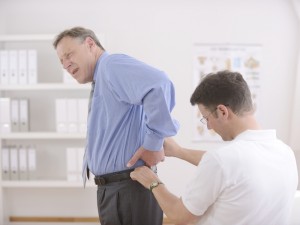What is a Slipped Disc?
 A slipped, or herniated, disc doesn’t actually slip, but it can move, split, bulge or rupture. Disc are special cartilage between the bones in your spinal column that act as protective, shock-absorbing pads. When the disc moves or splits, the cartilage and nearby tissue herniate, allowing pairs of nerves to exit the spine and escape into surrounding tissue. The leaking jelly-like substance places pressure on the spinal cord, or on a nearby nerve. While healthy discs give you flexibility for normal turning and bending, the resulting pressure on the spinal cord, and nerves causes quite the opposite effect.
A slipped, or herniated, disc doesn’t actually slip, but it can move, split, bulge or rupture. Disc are special cartilage between the bones in your spinal column that act as protective, shock-absorbing pads. When the disc moves or splits, the cartilage and nearby tissue herniate, allowing pairs of nerves to exit the spine and escape into surrounding tissue. The leaking jelly-like substance places pressure on the spinal cord, or on a nearby nerve. While healthy discs give you flexibility for normal turning and bending, the resulting pressure on the spinal cord, and nerves causes quite the opposite effect.
Causes & Symptoms of Slipped Disc & slipped-disc-treatment
There are numerous causes of a herniated disc. While it can happen with age, many disc problems are moreover the result of years of neglect. Many people experience no symptoms until the advanced stages of degeneration. There are also certain motions that can cause a slipped disc, like twisting or turning to lift an object. Lifting very large, heavy objects can place a lot of strain on the lower back, resulting in a herniated disc. This condition is especially prevalent in people that have very physically demanding jobs that require a lot of heavy-lifting because it places them at an increased risk. Individuals who are overweight are also at increased risk for a slipped disc because their discs have to support additional weight. This is especially true for people with weak muscles or who live a sedentary lifestyle.
The body part that is most frequently affected by a herniated disc is the lower back, but any disc can rupture, including those in the neck. While sometimes people don’t see any symptoms at all, any sign of this condition should be taken seriously and should be professionally treated. Symptoms of a slipped disc include:
- Pain and numbness, commonly on one or both sides of the body
- Pain that extends to your arms and/or legs
- Pain that worsens at night
- Pain that worsens after standing or sitting
- Pain when walking short distances
- Unexplained muscle weakness
- Tingling, aching or burning sensations in the affected area
An untreated, severe slipped disc can lead to permanent nerve damage. An example of a long-term complication is saddle anesthesia. This happens when the slipped disc compresses nerves and causes you to lose sensation in your inner thighs and the back of your legs. If you think you may be experiencing symptoms of a slipped disc, you need to see a doctor or chiropractor immediately. You should also seek slipped disc treatment after a traumatic fall or injury that involves a blow to the spine, if pain symptoms are severe enough to prevent you from walking, or if the symptoms are associated with severe numbness or weakness of any body part.
Chiropractic Care
Doctors often tell patients to rest, apply heat and take over-the-counter pain medications to relieve their symptoms. These approaches only mask the underlying problem. A chiropractor will help your condition by locating and correcting the area of your spine that’s interfering with proper nervous system control of your body. If there is uneven alignment above and below the disc, and how stable or unstable your spine is. We will perform a physical exam to determine the source of your pain or discomfort by checking your nerve function and muscle strength orthopedically, neurologically, and structurally. We’ll ask basic exam questions like when you first felt the symptoms and what activities make the pain worse.
Slipped disc treatment options can range depending on your pain or discomfort level and how far the disc is slipped out of place. Many studies show, the best treatment is to have chiropractic adjustments to help restore proper motion and position of the spinal bones. This will reduce nervous system involvement and help your spine return to normal, improved function. If it’s detected before there’s any permanent damage, disc tissue often returns to normal size and shape.
It’s often unadvised to refrain from all physical activity while you’re experiencing the pain and discomfort from a slipped disc because it can lead to muscle and joint stiffness. Instead, remain as active as you can through stretching and low-impact activities such as walking
To reduce your probability of developing a slipped disc you can perform a number of preventative measures. Practice safe lifting techniques by bending and lifting with your knees, not your waist and back. Maintain a healthy weight and active lifestyle. Get up and stretch periodically, especially if your job requires long hours of sitting down. Do strengthening exercises for the muscles in your back, legs and abdomen.
If you think you may be experiencing the symptoms caused by a slipped disc, contact Parkside today. Receive a free personal consultation, so that we can determine exactly what’s going on in your body and the best way to restore it back to normal!
